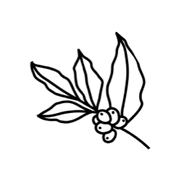-
Jose Maria Campos’s grandparents came to La Higuera in the 1940s, seeking affordable land in this remote area of the Colasay district, 200 miles east from their hometown of Piura. The district remains relatively isolated to this day, with a partially paved road to the community completed only in 2005. Coffee farms dot the hills in every direction, providing the primary source of income for the local residents.
During our first visit to La Hierba Santa in late 2022, it took more than an hour to walk from the nearest unpaved road to reach the beginning of Jose’s property. His four-hectare farm spans 1800–1950 MASL and is planted primarily with a unique variety locally known as ‘Bourbon de Colasay,’ along with a small amount of Catuaí. Jose depulps his coffee cherries the day after harvesting, placing the sticky parchment in plastic bags under shade to ferment for two to three days before washing the coffee in a wooden tank. Afterward, the coffee is placed in solar dryers until it reaches the ideal moisture content– a process that takes anywhere from 10–20 days, depending on the weather.
Bourbon de Colasay trees bear an uncanny resemblance to traditional Bourbons, though they produce more fruit and are highly resistant to Coffee Leaf Rust—a blight affecting nearly all coffee growing regions across the world. Genetic testing shows this variety is quite different from Bourbon, resembling the genetics of Catimor. Catimors are a family of introgressed varieties, meaning they stem from an early cross of two different species of coffee—Arabica and Robusta. Oddly, Bourbon de Colasay shares genetic markers with Catimors, but doesn’t match any known Catimor variety, suggesting it may have originated from a local cross-pollination or mutation. While Bourbon de Colasay has the production benefits of Catimors mentioned above, it lacks the vegetal and astringent flavors often found in the Catimor family.
-
Harvest
Process: Washed
Certifications: Organic, Kosher
Elevation: 1,800-1,950 meters
Variety: Bourbon de Colasay
Harvest Time: July 2024–September 2024
Available: Through mid-March 2025
-
Origin Coffee Lab
Length of Partnership
1995 2017 20259 years
Location

-
We believe in paying more.
Since 2009, we have published an annual transparency report to serve as a blueprint for our green coffee purchasing practices and a response to chronically low prices in the coffee industry. We believe paying more for green coffee is an important investment in the long-term viability of our coffee-growing partners’ businesses and our supply.
$0 $5$4.25 FOB (Free on Board)/lb - Our price for La Hierba Santa
$3.07 FOB/lb - Fair Trade Certified Minimum
$2.47 FOB/lb - Average C Market Price
-
![]()
Sustainably-Sourced
-
![]()
Quality-Focused
-
![]()
B Corp Certified
-
![]()
Transparently Traded
![]()
Sustainably-Sourced
![]()
Quality-Focused
![]()
B Corp Certified
![]()
Transparently Traded











